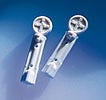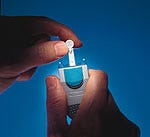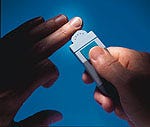A Pain-Free Alternative for Diabetics
March 1, 1999

A Pain-Free Alternative for Diabetics
User-Centered Design Was the Key to Bayer's Award-Winning Lancet
By Sally Lane, Senior Editor

For diabetics, monitoring blood glucose levels is a daily fact of life. The tests allow them to quickly assess their blood chemistry in order to circumvent life-threatening elevations or declines in blood sugar. Proper monitoring can mean up to nine tests a day, each one requiring a painful needle stick in the finger.
Seeing the need for a less painful, easy-to-use testing device, Bayer Corp.'s Diagnostics Business Group (Elkhart, IN) approached Metaphase Design Group (St. Louis) to create a state-of-the-art lancet. The result was the Bayer Microlet Automatic Lancing Device, which has been a commercial success for Bayer and resulted in a prestigious design award for Metaphase.
Getting to "Yes"
For Metaphase, one of the first steps in the design process was to conduct extensive one-on-one interviews with diabetic patients of various ages and levels of disease to "learn how they live with their disease," says Bryce Rutter, CEO at Metaphase. "The discovery phase included trying to understand what their wish list was, the problems they currently experienced with existing devices, and the ergonomic constraints they would pose on a product like this," he says.
One problem identified with the existing devices is that they are difficult to operate. Traditional pen-shaped lancets require the user to grasp the device with three fingers and stand it up vertically so the only thing touching their hand is the tip of the pen, Rutter explains. "When you think about trying to hold a pen-shaped device to stick your finger, it's probably the worst design going," he says. "It's also difficult to see where you're going to prick yourself." To complicate matters, many diabetics have vision or motor control problems, making such devices even more difficult to operate.
Metaphase also asked the research subjects how often and where they conducted their blood tests, and asked them to bring their current diabetic supplies to the interview site, transporting them in the way they typically would. "We videotaped and documented how much junk they had to carry and the ways they had personalized it," Rutter says. This research revealed that convenience was one of the users' main concerns. "The vast majority said, 'Why does all this stuff have to look like medical equipment, and why is it so large?' " The group members asked for a product they could conceal in their hand when using, and for a device they could carry in their pocket.
 To conduct a blood test with the Microlet the user simply inserts a lancet until it clicks into place, positions the device against a finger, and presses the release button.
To conduct a blood test with the Microlet the user simply inserts a lancet until it clicks into place, positions the device against a finger, and presses the release button.

"We showed them a set of first-tier designs and asked them a battery of questions related to their perception of various aspects of product performance. We then showed them a set of second-tier designs, and, lo and behold, everyone pointed to the same design!" It featured a small, flat device that fit in the palm of the hand and was easy to manipulate.
"We tried to design the Microlet based on the worst-case scenario, so that it would allow someone to operate it using gross motor control rather than precision motor control," Rutter says. To make the device easy to operate, Metaphase textured the "grip" to guide the user's hand. They also colored the grip and the release button so people with vision problems could see them better. Another design innovation was to curve the lancet port so users would have a better view of the lancet contact point when conducting a blood test.
The Production Process
Metaphase approached Bayer's engineering team with what they thought was a foolproof design, but the Bayer engineers were convinced the design couldn't be mechanically executed. "They said you can't take a linear mechanism and cut it in one third and make it happen," Rutter says. Despite the challenges it presented, Joe Ruggiero, Bayer's director of engineering for instrument systems, was determined to create the new product, Rutter says.
Given the green light, Metaphase created scale models out of high-density foam. "We identified a short list of designs we felt were the most promising, then developed photorealistic illustrations on a computer," Rutter says. After developing two-dimensional foam models, Metaphase researchers met again with the diabetic subjects to obtain feedback on the designs' potential usability and ergonomics. The winning design from this phase was then documented with CAD drawings for the Bayer engineers, who in turn executed the mechanical design of the Microlet. Once this stage was completed, prototypes were constructed and tested internally.
Not only did Bayer engineers figure out how to execute the design, but "they did something really cool," Rutter says. They created a mechanism for the Microlet that would deliver a more precise, less painful, finger prick. The traditional pen-shaped devices are designed in such a way that when the needle hits, it bounces back and pricks the finger a few more times around the initial puncture site, Rutter says. "According to research, one of the major contributors to pain is the second, third, and fourth strikes of the lancet," he says. The Microlet eliminates this problem by sticking the user only once. In one study conducted by Bayer, 94% of the patients who tested the Microlet said they found it less painful than the product they were currently using.
In addition to usability issues, aesthetics were also a concern in designing the Microlet, particularly when it came to deciding where to place the product's parting lines. "In any small handheld product, you must place the parting lines to accentuate the form and quality of the product and place them in a way that they cannot be detected by the hand," Rutter says. In terms of materials, it was pretty much a "no brainer," Rutter notes. "Bayer chose materials typically used in medical devices—ones that won't stain and that are easy to clean and color. They also needed to choose materials that could take the shock and impact typical in the use of a lancet."
The end product consists of a durable ABS plastic shell and a stainless-steel needle. After looking at several manufacturing methods, Bayer chose an injection molding process because of its ability to produce high volumes of precision parts.
Everybody Wins
Bayer's Microlet, introduced to the marketplace in 1997, has been a "stellar success," Rutter says. The device also reaped a 1998 Good Design Award for Metaphase. The microlet is being included in the permanent collection of The Chicago Athenaeum, Museum of Architecture and Design, the sponsor of the competition.
Rutter cites user-centered design as the key to the product's success. "Robert Williams, Bayer's manager of product planning and business development, believed that Bayer shouldn't develop the product internally because they're not diabetics. I know it sounds logical, but the vast majority of products are developed by manufacturers with no more than traditional market research. The outcome is that Bayer has made life better for diabetics and, as a result, made life better for themselves, in terms of sales."
MPMN is seeking success stories like this. If your company has one to share, please contact managing editor Karim Marouf at 11444 W. Olympic, Ste. 900, Los Angeles, CA 90064-1549; 310/445-4200 or e-mail [email protected].
You May Also Like


